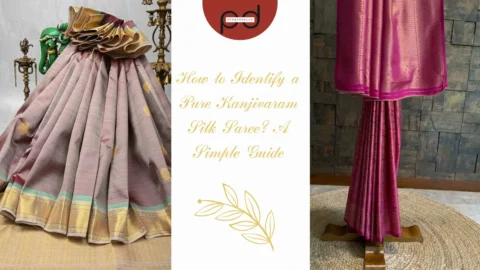Introduction
Kanjivaram silk saree is not just a name, it’s a brand. Hearing its name evokes a royal and elegant feeling.For the people of South India, it’s not just a saree, but a part of their culture, art, and tradition.Every Kanjivaram saree reflects the hard work of the weaver, the perfection of the design, and the natural brilliance of the silk.If you still want a pure Kanjivaram silk saree, there’s nothing to worry about.
Through this blog, we'll explain in very simple and easy terms:
- How to identify a pure Kanjivaram silk saree
- What points to check
- And how to ensure your purchase is 100% authentic and long-lasting
Objective
The main objective of this content is to help people understand how to identify a pure Kanjivaram silk saree.You will see many sarees in the market that look exactly like the original, but they are duplicates and machine-made, and there is a huge difference in their quality and value.
We want to tell readers that :
- This saree isn’t just a piece of cloth, but a symbol of South Indian heritage and craftsmanship.
- This can be understood as the silk, zari, and weave of a genuine Kanjeevaram saree are very different.
8 Easy Ways to Recognize the Royal Weave of a Kanjivaram Saree

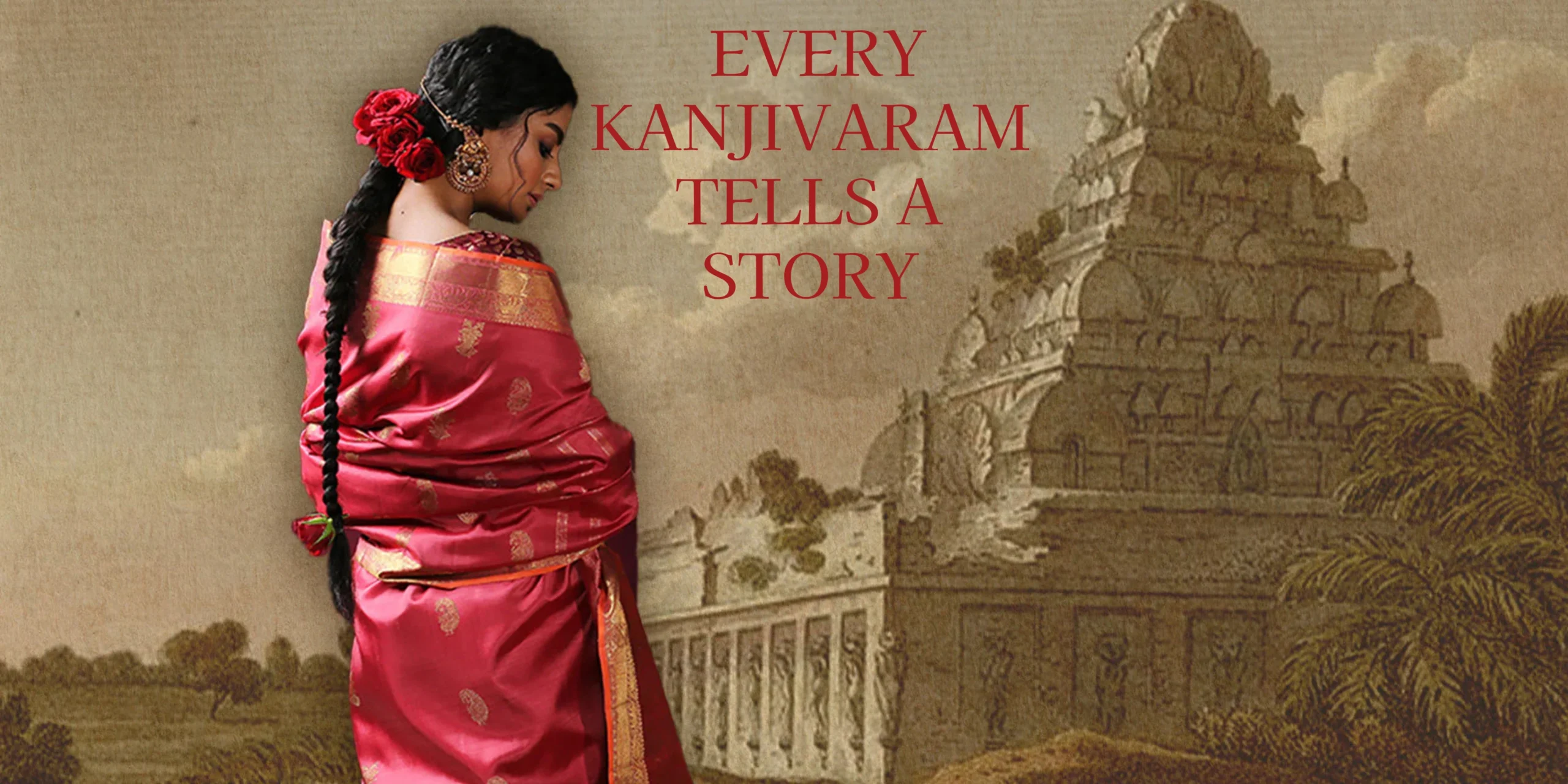

1. Look for the Silk Mark Tag
- Whenever you buy a Kanjivaram silk saree, first check for a Silk Mark tag, as the tag proves that it is 100% pure silk.
- If the tag is missing, there’s a high chance the saree is blended or a duplicate.
2. Notice the Glow of Real Zari
- If you look at a real zari, its shine is a bit like gold—very soft and classy.
- Fake zari is brighter and quickly darkens or dulls.
3. Observe the Korvai Border
- The Kanjivaram’s border and body fabric are woven separately and are stitched together—that’s why it’s called a Korvai border.
- You won’t find this fine joining in machine-made sarees; it is all woven together.
4. Feel the Silk and Listen to Its Sound
- Real silk, when rubbed lightly, has a soft “rustling” or “chiming” sound – a soft little clink.
- Synthetic silk has neither the sound nor the softness.
5. Check the Weight and Drape
- Authentic Kanjivaram sarees are a bit heavy but when you wear them, they flow naturally and give a royal feel.
- Fake sarees are lightweight with less graceful fall.
6. Look at the Reverse Side
- Flip the saree over, and if the weaving is apparent, it is indeed handloom.
- The backside of a machine-woven saree is entirely clean with no visible weaving.
7. Be Smart About the Price
- Original Kanjivaram is not cheap, so care with the price is warranted because it is pure silk and gold zari work.
- You should buy from trusted handloom or certified silk mark stores.
8. Every Kanjivaram Tells a Story
- Every Kanjivaram saree tells a story—of age-old tradition, culture, and craftsmanship.
- It’s not an outfit, it’s a feeling, passed down from mother to daughter.
Still in Doubt? Let’s Test It!
After reviewing these 8 methods for confirming if a Kanjivaram saree is authentic or not, you should now clearly know if your saree is real.
However, sometimes, you may have some doubts despite looking at the clues visually, and this is when the testing step comes in.
Now it is time to demonstrate some simple and safe testing methods you can use at home, to verify your Kanjivaram saree authenticity.
Testing of Kanjivaram Silk Saree( At home )
1. Burn Test :
- Pure silk smells exactly like hair when burned and turns into soft ash.
- Synthetic silk emits a plastic-like smell and forms a hard ball.
- ⚠️ Only perform this test on the thread, not the saree.
2. Water Absorption Test :
- Real silk absorbs water easily and feels wet.
- Fake silk beads water and rolls off, so it does not absorb.
3. Sunlight Shine Test :
- Silk has a soft, warm, and understated sheen, which will vary slightly with changes in angle and light.
- Fake silk has a very bright sheen and a uniform luster; there will be no change in surface color.
4. Thread Pull Test :
- Threads made of Kanjeevaram silk are strong and resilient; they will not break under normal use.
- Synthetic threads have little or no resistance to stretch; they will break with slight tension.
5. Smell Test :
- Genuine silk has a light, natural smell, especially when slightly damp.
- Artificial silk has little or no smell or has a chemical type of smell
Difference Between Pure Kanjivaram Silk and Other Silk Sarees
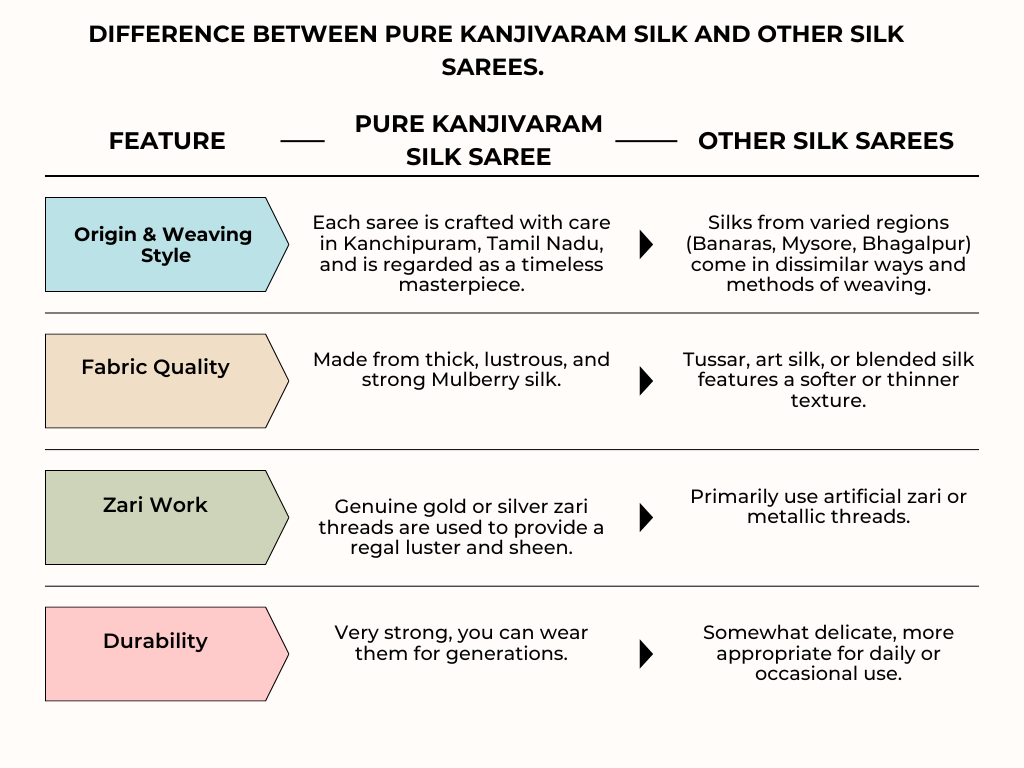
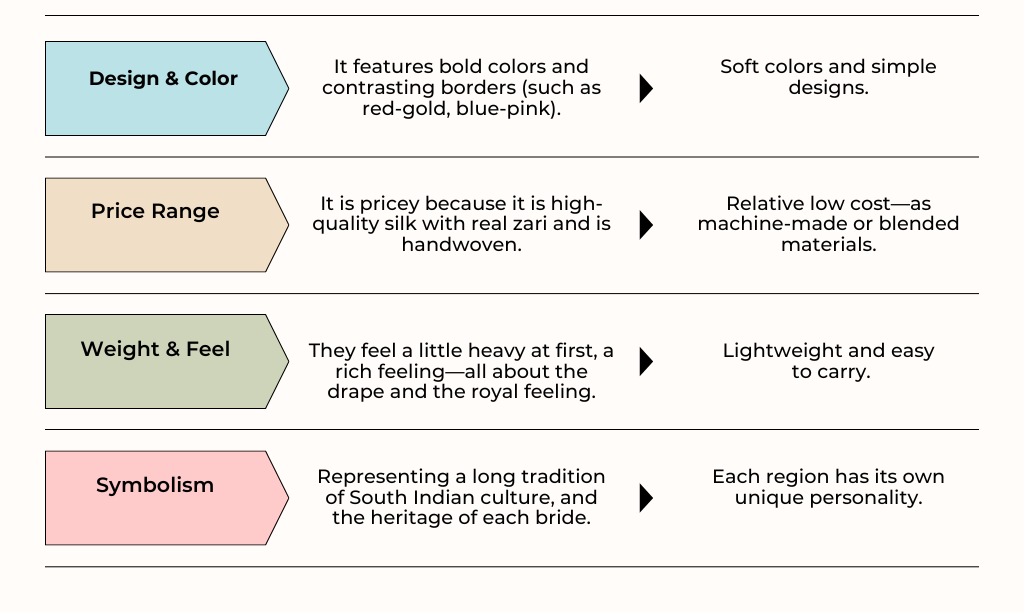
Target Audience

1. Women aged 25–55 years:
This is for women who love traditional Indian wear and want to invest in high-quality sarees.
2. Brides & Brides-to-be:
Those who are looking for a premium and royal saree for their wedding or dowry.
3. Saree Lovers & Fashion Enthusiasts:
Those who love and appreciate handloom and authentic silk collections and want to understand their uniqueness.
4. Cultural & Heritage Fashion Followers:
For individuals who want to preserve Indian culture, weaving traditions, and crafts like Kanjivaram silk.
5. Authentic Products Buyer:
Individuals who want to avoid counterfeit sarees and are looking for genuine and certified sarees.
6. Gift Shoppers:
Those who want to gift their loved ones something pure and classy—like this pure Kanjivaram silk saree.
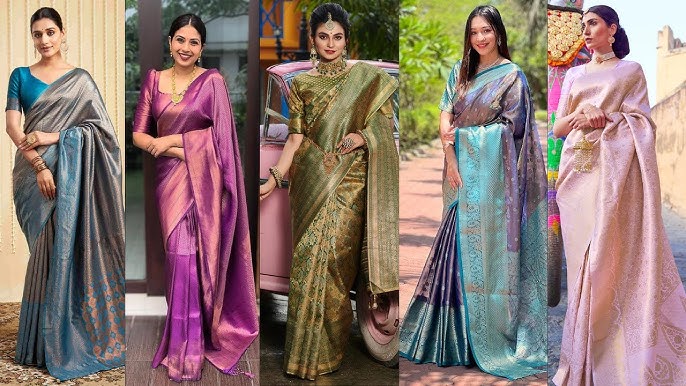
Conclusion:
These days, we see so many fake and mixed silk sarees easily available in the market, which is why identifying a genuine Kanjivaram silk saree has become a bit difficult. But if you know the basics of texture, zari, weight, and weave, you can easily identify a pure Kanjivaram silk saree.
Remember:
- Real Kanjivaram silk is always rich, soft, and slightly heavy.
- Its zari work is done with real gold or silver thread.
- And most importantly, its designs and color combinations have a royal elegance that is never found in duplicates.
If you ever have any question, you can check with easy tests (like burn, water, or thread tests). And to ensure you are buying authentic products, you must shop from Silk Mark certified retailers or trusted handloom weavers.
Frequently Asked Questions ( FAQs )
1. How can I identify a pure Kanjivaram silk saree?
Pure Kanjivaram silk is slightly heavy, soft and has a shine. The zari will be real gold/silver and there will be a contrast in color between the border and the pallu.
2. How do I test if my Kanjivaram saree is real or fake?
You can burn a small thread and smell it; if it smells like hair and the ash from it is soft, then it is real silk.
If it smells like plastic then it is fake.
3. Why are Kanjivaram sarees so expensive?
Because Kanjivaram sarees are hand woven from pure mulberry silk and with real zari; it is a work of art worthy of royalty.
4. What’s the difference between Kanjivaram and other silks?
Kanjivaram silks are thick, glossy, and durable , while other silks (Banarasi , Tussar, etc.) are lighter in comparison and have a subtle shine.
5. Where can I buy authentic Kanjivaram silk sarees?
Always buy Silk Mark certified shops or trusted handloom websites, this is the best proof of authenticity.






